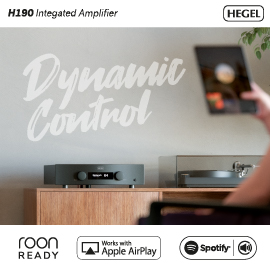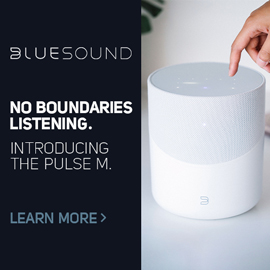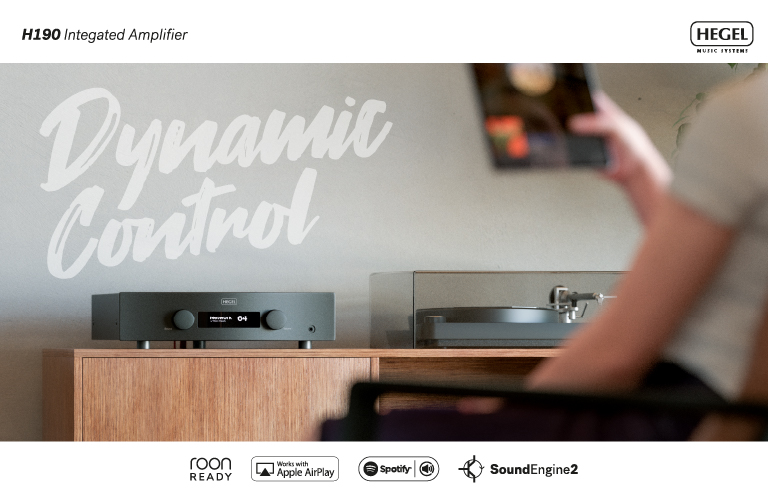About two years ago, I became quite critical of hi-fi shows. We were in the middle of the pandemic, there hadn’t been a hi-fi show in over a year, yet most companies were selling more products than they had sold in years.
As a review publication, we had no shortage of products to write about, so it wasn’t as if we needed to go to a show to scout things out. For consumers, the lack of shows seemed to make no difference when it came to finding new products—a Google or YouTube search would give them all the information they needed. It made me wonder whether the hi-fi shows that went on pre-COVID needed to come back post-COVID.
Of course, hi-fi shows have been back in 2022, and most have had reasonable success so far. But I can’t say that the ones I attended were more successful than they were before the pandemic—except for Audio Video Show (AVS) 2022, held October 28 to 30 in Warsaw, Poland. I attended this show with writer Jason Thorpe, who’d come with me to Warsaw for the show in November 2019, the last time it was held, before the pandemic closed it down for two years.

From what I could tell by the end of this year’s AVS, there were at least as many exhibitors now as there were in 2019, and there seemed to be more attendees. I recently wrote to the show’s owner and organizer, Adam Mokrzycki, to confirm this impression. He told me that this year’s show had as many exhibitors as in 2019 and more than 14,000 attendees, which was the “second best attendance in history,” he noted. Mokrzycki also added that if there were “only 200 more people in 2022,” it would have broken 2018’s attendance record. So, yeah, it bettered 2019 and almost all the Audio Video Shows before that.
Insofar as the value of hi-fi shows goes, Audio Video Show 2022’s success changed my outlook. A little. My thinking right now is that we still don’t need all the shows we had before the pandemic, but good ones, like Audio Video Show, should carry on.
That said, I do have some bad news about Audio Video Show 2022: there were not as many product introductions as there had been in previous years. None of the exhibitors told us exactly why, but I had a feeling when I was there—and still have today—that it was probably due to the supply-chain shortages that have been plaguing most industries, including hi-fi, for nearly two years. Simply put, many companies aren’t putting new products out, so they weren’t showing anything new at Audio Video Show 2022.

As a result, we didn’t find as many new products as we would have liked to as we scoured the busy halls for our show coverage on SoundStage! Global. Still, we did find some interesting things, including three products that stood out. These three products are now the Best of Audio Video Show 2022 and are listed below in the order we encountered them.
Fezz Audio Titania stereo/mono amplifier
The first standout product we found was the Fezz Audio Titania power amplifier, which is part of a new amplifier series called Evo. (The company also has a Titania model within its Legacy series, which debuted in 2016 and is still produced.) The Evo Titania is a traditional class-AB push-pull amplifier armed with two ECC83 driver tubes and a quartet of KT88 output tubes. The Titania’s claimed power output is 45Wpc into 8 or 4 ohms as a stereo amp or 90W into the same loads in mono operation. At the Audio Video Show, a pair of Titania amps was operating as monoblocks.
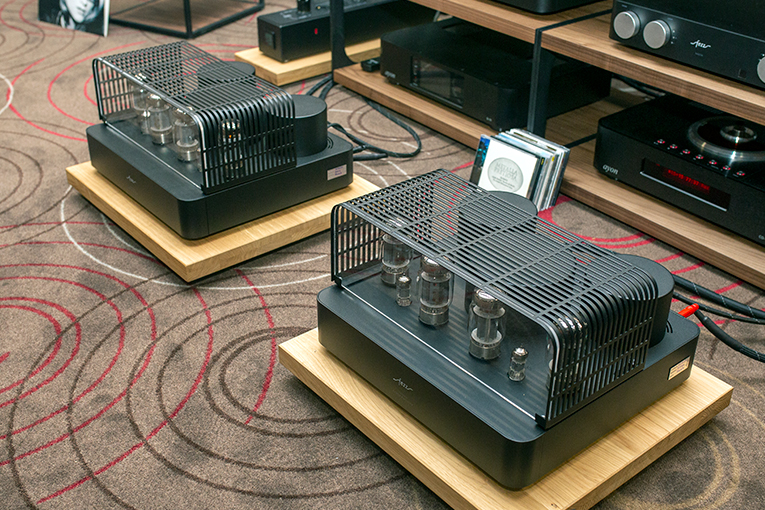
We found the Evo Titania on the second day. Jason Thorpe was so thrilled by what he saw and heard that he wrote an article the same day titled “The Bargain of the Show So Far,” a title that reflects one extraordinary feature of this product: its price. At just 11,000 Polish złotys (about €2350 or $2430 USD), the price seemed way too low. Fezz’s stated European price is €2775, but that includes Europe’s VAT (value-added tax).
When we first saw the Titania, we thought it would sell for double, if not triple, that price. Its styling is great, its build quality seems excellent, and it’s not manufactured in China as so many low-price tubed products are today. Labor costs are admittedly lower in Poland than in some other parts of Europe but not that low. It also comes in seven finishes, most with interesting names: Black Ice, Big Calm, Burning Red, Republika, Evergreen, Moonlight, and Sunlight. Furthermore, Fezz Audio isn’t some fly-by-night manufacturer, nor is it an upstart manufacturer discounting prices to get noticed. Fezz Audio was founded by Maciej Lachowski in 2014 and has steadily grown and expanded its product line, which now includes integrated and power amplifiers, headphone amplifiers, phono stages, a line-stage preamplifier, and various accessories. This company is the real deal.

Just before we left the Fezz Audio booth, Jason offered Lachowski to review the Evo Titania, which he agreed to. How we go about getting one on this side of the Atlantic, however, is still up in the air. When we heard the price of the Evo Titania, Jason and I were both tempted to buy one right on the spot—I was thinking I’d get mine in Big Calm or Burning Red. But we both knew that getting it home wouldn’t be easy. It’s too big for a suitcase, and there’s no way they’d let us carry it on. So if you’re interested in one of these amps, get moving, because I wouldn’t be surprised to see the price go up one day.
Silent Pound Challenger loudspeaker
Five minutes after we saw the Titania amplifier, we walked into the Silent Pound room and encountered this new Lithuanian company’s first loudspeaker, called Challenger, which is apparently six months away from being a finished product. When released, it’s expected to sell for €10,000 per pair.

The Challenger is equipped with five drivers in total. Topmost are two 6″ midrange drivers vertically flanking a 1″ compression tweeter. Below those three drivers are two 12″ woofers. The speaker’s cabinet is quite shallow, and the section where the woofers are has no back wall—those two drivers are operating in free air. Furthermore, the midrange drivers have an innovative chamber behind them (patent pending) that redirects their rearward projection to the perforated front baffle, which creates a cardioid dispersion pattern. A deep waveguide controls the directivity of the tweeter so its output matches that of the midranges. Vertical lobing issues are said to be mitigated by using a very low crossover point between the tweeter and midranges.
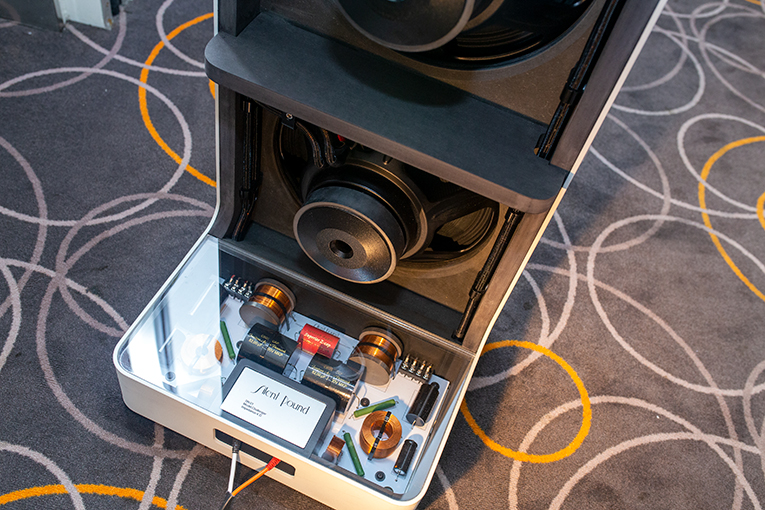
I already wrote about my experiences looking at and listening to the Challenger while I was in Warsaw. I haven’t learned anything more about the speaker since, and I still don’t know what the company name means, though I’d like to. But I must say that this speaker has some interesting and thoughtful acoustical engineering behind it, which is suggested by its unique design. When I first saw it, I said to Jason Thorpe, “It’s either something special or shite.” Right now, I’m betting on the former. In fact, I thought it was one of the best products—if not the best product—in Warsaw this year.
Aretai Contra 100S loudspeaker
I discovered the Aretai Contra 100S loudspeaker at the end of the third and final day, after I thought we had already finished covering everything we needed to. It took but one look at the Contra 100S and a quick listen to know that we hadn’t. I dug out my camera and laptop and made sure to include the 100S in our show report while we were still there.

As I wrote in my article on it, “the 100S is priced at €7500 per pair and is a two-and-a-half-way design with two 6″ drivers—one on the front, the other on the back—and a 1″ soft-dome tweeter nestled deep in a waveguide that extends higher than the cabinet.” I also pointed out that it has no port; it’s a sealed enclosure. But while many sealed-enclosure loudspeakers lack deep and powerful bass, that Contra 100S pair demonstrated remarkably deep and detailed bass, and sounded extremely natural and well-balanced in the midrange and higher frequencies.
Besides the sound, I also liked that this wasn’t another ho-hum, conventional speaker design—some sort of box with drivers on the front and nothing noteworthy to speak of. The woofer on the back, sealed enclosure, MDF-and-plywood cabinet construction, and unique placement and design of the waveguide make the 100S a truly distinctive product. The 100S has two floorstanding siblings, the 200F and 350F, but it’s the 100S that intrigues me most right now.
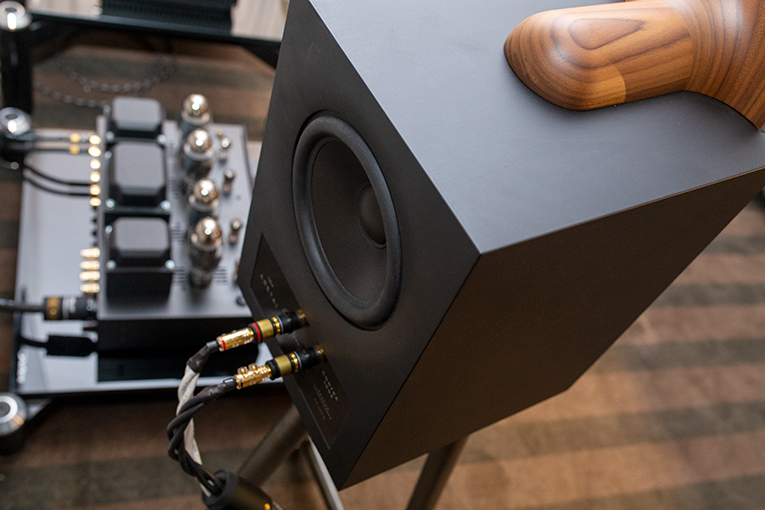
Just like with the Challenger, I have no further details on the Contra 100S just yet. But I have been in contact with Jānis Irbe, Aretai’s founder and owner, who told me that he’d like to send us a pair for review once backorders are filled. He appreciated the coverage at the show and was pleased to learn that our reviews include measurements, something few publications do these days. I hope we get to review the 100S, though it might be tricky—the company is in Latvia and has no North American distributor. But I’m sure we can find a way to make it happen. This is a speaker the world needs to know more about.
The next show
As I’m typing this, Capital Audiofest, which was held from November 11 to 13 in Rockville, Maryland, wrapped up a few hours ago. I wasn’t there, however, because the scheduling of that show was too close to Warsaw’s Audio Video Show and to a trip in late November to Germany and England. Therefore, AVS 2022 ended our show coverage for the year, but it did so on a high note, given its success.
The next show we cover will be the Florida International Audio Expo, to be held February 17 to 19 in Tampa. I think the organizers made a wise decision, when they created the event in 2019, to stage it in February, when Florida’s weather is ideal—a strong incentive for many to attend. But more important for hi-fi enthusiasts is that staging this event in February means it is the kickoff show for the year. For those two reasons, Florida Audio Expo still has a very good reason to exist, and I’m looking forward to being there!
. . . Doug Schneider
das@soundstagenetwork.com





